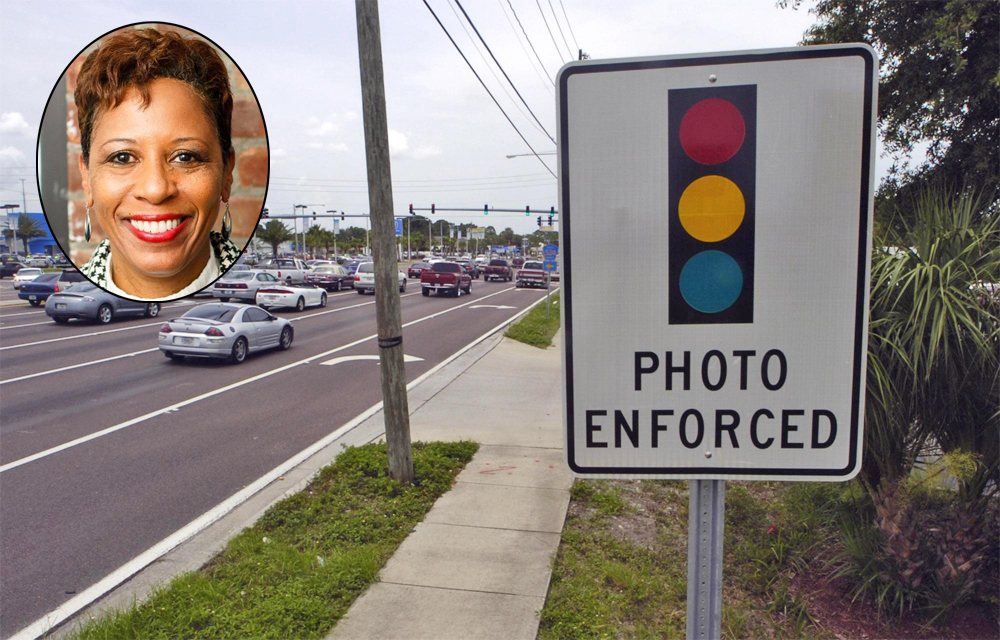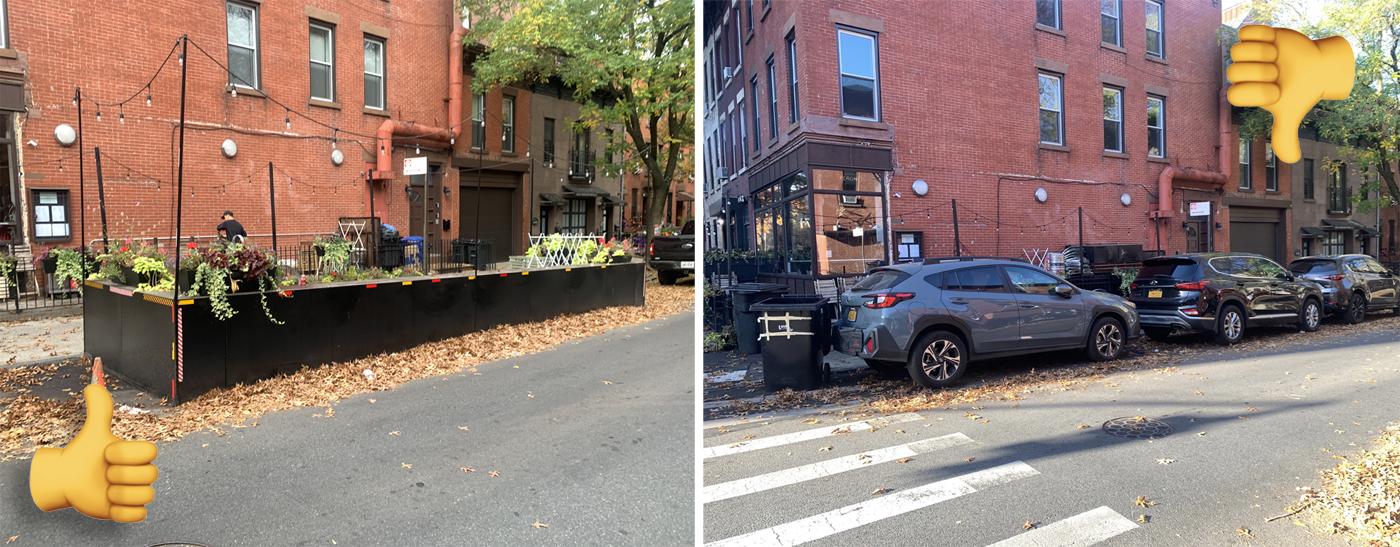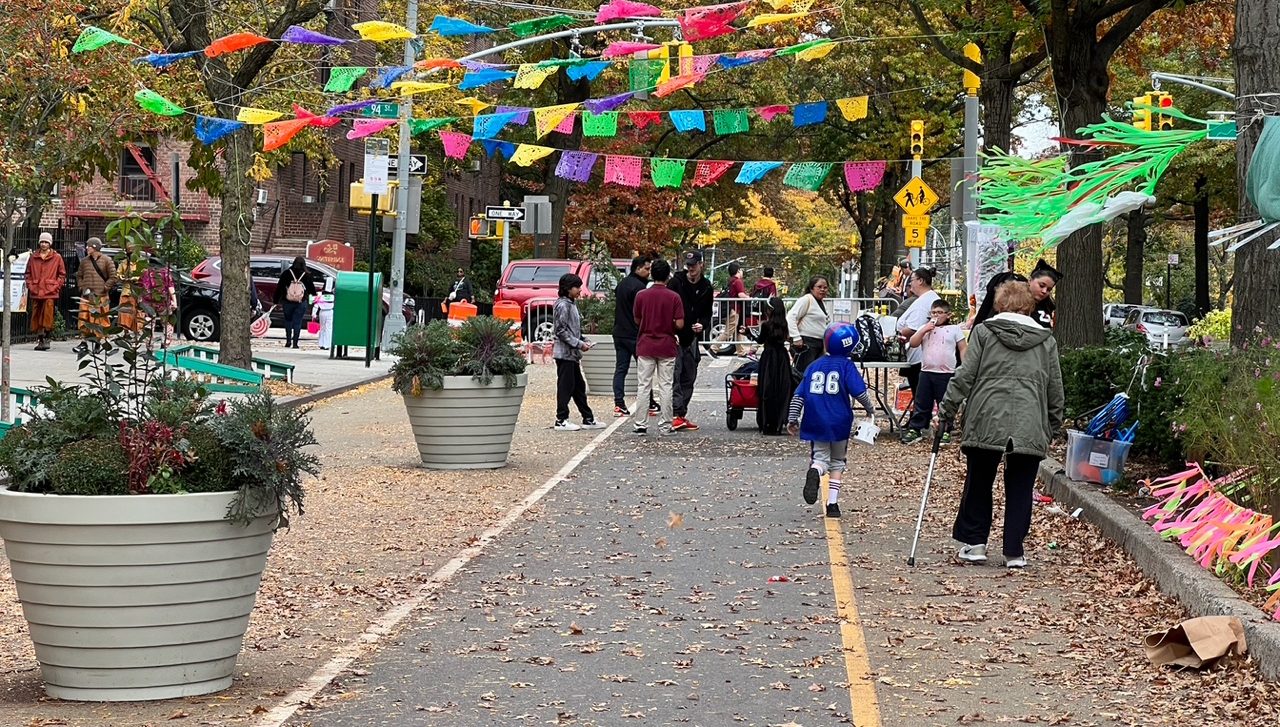Show them the money.
As Mayor Adams heads to Albany this week to win over state lawmakers to reauthorize the life-saving speed camera program that expires on July 1, he's facing a mini revolt in the East Wing of City Hall, where some Council members who aren't sold on speed cameras are demanding that camera revenue be allocated to fund road improvements in their districts, Streetsblog has learned.
After Streetsblog broke the news last week that the Adams Administration’s hopes of winning full control speed cameras in Albany was dead, a significant number of Council members spoke out in a closed-door meeting against expanding that very speed camera program, which has helped lead to a dramatic 72-percent reduction in speeding at locations with cameras. The cameras will be shut down unless Albany renews them — and street safety advocates should be alarmed because Albany leaders are expecting the Council to send what’s called a "home rule message" — a formality that has now become a significant hurdle.
The last day for the Council to vote on home rule would be the next stated meeting on Thursday — just days before session in Albany ends on June 2.
“Home rule was discussed at length," a Council staffer who requested anonymity told Streetsblog. "Concerns from a number of Council members were articulated. There was meaningful pushback from some members, making it less likely that [home rule] might happen," though the staffer did add that it's “not inconceivable."
Moving forward appears to depend on the Adams administration changing longstanding city policy to not merely bank the anticipated $169 million in speed camera revenue this year, but use the revenue to fund specific road safety projects in neighborhoods where the money is generated — which includes many low-income communities of color that have wide, speedway-like arterials that have not been redesigned for safety as they have been in white neighborhoods, a Streetsblog analysis showed.
“I am a supporter of (home rule), the cameras as well," said Council Member Selvena Brooks-Powers, who chairs the Council’s Transportation Committee and has been caught speeding in school zones 17 times in the last 11 months, during her committee's budget hearings last week. "But I do want to talk about the revenue that comes from it. We know over $200 million is collected from city bus lanes, speed, red light cameras, all revenue is collected and goes into the city general fund. Does DOT receive back any revenue?”
Council Member Charles Barron (D-East New York) more wholeheartedly endorsed the need.
“We have some of the highest fatalities and accidents, yet we don't see the highest amount of resources,” said Barron during the virtual hearing.
Barron told Streetsblog on Friday that he supports speed cameras, and voted for them when he was a member of the Assembly from 2015 through last year, but wouldn’t say explicitly whether he would support a home rule message for expanding the speed camera program.
“I think it’s a good thing, especially near schools,” he said. “I have to look at [home rule] with my staff. … I support anything that saves the life of a child.”
None of the sources Streetsblog spoke to named their colleagues who expressed concerns over expanding the speed camera program, but a Council spokesperson confirmed that the issue is money.
Council members want to “ensure (the revenue) returns to communities with unsafe streets for street safety redesign/calming measures,” the spokesperson said, and “hold DOT accountable for investing in safe street redesign for communities that have been underinvested in.
“The Council is working with the state legislature and Mayor Adams’s administration on the bills actively in discussion in Albany to advance New York City priorities for safer streets in all communities," the spokesperson added.
Council Speaker Adrienne Adams (D-Jamaica) declined a request for an interview. But she’s previously been on the record as dubious of speed cameras. Back in January, Adams sympathized with a Staten Island speedster who didn’t want to pay the price for her reckless driving — seeming to agree when the driver said it is a “well acknowledged” theory that speed cameras are a way to nickel and dime New Yorkers.
Advocates also support the idea of using camera revenue to redesign streets so that drivers would be unable to speed.
"The whole point is for streets to get the investments and redesigns needed to reduce speeding and violations over time," said Cory Epstein, spokesperson for Transportation Alternatives. "This is also why we are encouraging city and state officials to support earmarking fines collected from speed safety cameras so they are reinvested to make streets safer in the neighborhoods where speeding occurs."
Danny Pearlstein of Riders Alliance agreed.
“We would love to work with the Speaker and Chair on a policy that spends the revenue in the community district it’s collected,” he said.
A spokesperson for DOT told Streetsblog that the city invests far more in Vision Zero than what is raised in revenue from cameras — it’s spent $1.7 billion since 2014 on road safety, more than triple the revenue generated by the speed camera program. And the agency said it is addressing systemic inequities in investment with a new formula to determine where the most-crucial street investment should be made, based on factors such as crash data, income level, and racial demographics. And Mayor Adams did pledge $904 million in new revenue for Vision Zero projects over the next five years.
“We are having productive discussions with legislators and we’re optimistic the Council will pass a home rule message to expand and enhance these life-saving programs,” said DOT spokesman Vin Barone.
If a home rule message is sent up the river, state lawmakers will use it to consider SB5602 by state Sen. Andrew Gournards that would allow cameras to operate 24 hours a day, seven days a week, instead of the current just 6 a.m. to 10 p.m. on weekdays. The bill would reauthorize the camera program through July 1, 2025.
The bill has other provisions that are starting to draw attention as more and more lawmakers focus on the issue, including:
- The bill would require the Department of Motor Vehicles to tell insurance companies whenever a car gets five school-zone speeding tickets in any two-year period. The goal is to encourage insurance companies to hold drivers accountable with higher rates.
- It wold also suspend the registration, for 90 days, on any car slapped with six camera-issued tickets within two years. Currently, camera-issued tickets do not count on a driver's record, and this is seen as a way around that.
- Another section of the bill would allow for increasing fines after a driver gets five tickets in two years. This section "also eliminates the provision in current law which bars speeding violations from becoming a part of a driver's record or used for insurance purposes," the bill states.
Gounardes said he’s “optimistic” that the bill will pass the legislature, but it's not clear that the bill will pass intact.
Streetsblog reached out last week to Albany lawmakers whose districts had the worst road violence in the last two years and found that most were supportive of speed cameras, but got less supportive when the bill's other clauses were mentioned.
Sen. Roxanne Persaud, whose East New York/Canarsie district has suffered 31 fatalities in two years, is a strong supporter of speed cameras. But when Streetsblog asked about the insurance provisions, she backtracked.
"Sharing information with insurance companies?" she said. "We'll have a problem with that. Cameras are ticketed to the car, so there will be unintended consequences, like who was driving the car?"
A staffer to another Assembly member also said the lawmaker strongly supports cameras — but not all the other provisions of the bill.
And Assembly Member Khaleel Anderson (D-Queens), who is a supporter of speed cameras and has been endorsed by StreetsPAC, questioned whether extending the cameras' hours to all day every day would be equitable.
"My general way of governing is to be less punitive and to use more education," said Anderson, whose district has experienced 20 road deaths and 2,502 injuries in two years. "Safety is on the line. I had an 11-year-old killed in my district this year. so I agree with the spirit of the legislation."
The spirit?
"The controversial part is the 24-7 extension," he added. "Many of my constituents are concerned that if the cameras are turned on 24-7, it will disproportionately affect Black and brown communities, where the roads encourage speeding. It's psychology; folks see a wide street and they think they can speed."
He said he would vote for the bill ... "with amendments."
"We have to hold drivers accountable," he said.
Assembly Member Dick Gottfried, who has represented the Upper West Side of Manhattan since Nixon was president and is proudly not a car guy, said his colleagues in Albany love supporting bills ... until they see themselves being bound by them.
"I've been watching this since I arrived here 52 years ago," he told Streetsblog. "Whether it is drunk driving, sexual harassment or traffic enforcement, when you deal with issues that legislators can imagine themselves being the targets of, it becomes very difficult."
Gottfried described himself as "an enthusiastic supporter of speed cameras and red light cameras" who believes that "New York City ought to have home rule authority to install them wherever and whenever it wants." But his colleagues mostly drive — and that's a problem.
"The reason there is opposition among some legislators is that a lot of legislators can see themselves getting those tickets," he said. "It's easy to be for strong law enforcement when it applies to somebody else. You hear it in floor debate. It is always shocking to me after all these years that people put that concern on a higher level than saving lives."
Sens. James Sanders Jr. (whose district had 32 killed in two years), Alessandra Biaggi (30 killed), and m) Jabari Brisport (whose district led the way with 4,708 injuries in two years) and Assembly members Jaime Williams (16 killed) and Nikki Lucas (15 killed and 2,451 injured) did not call back.






